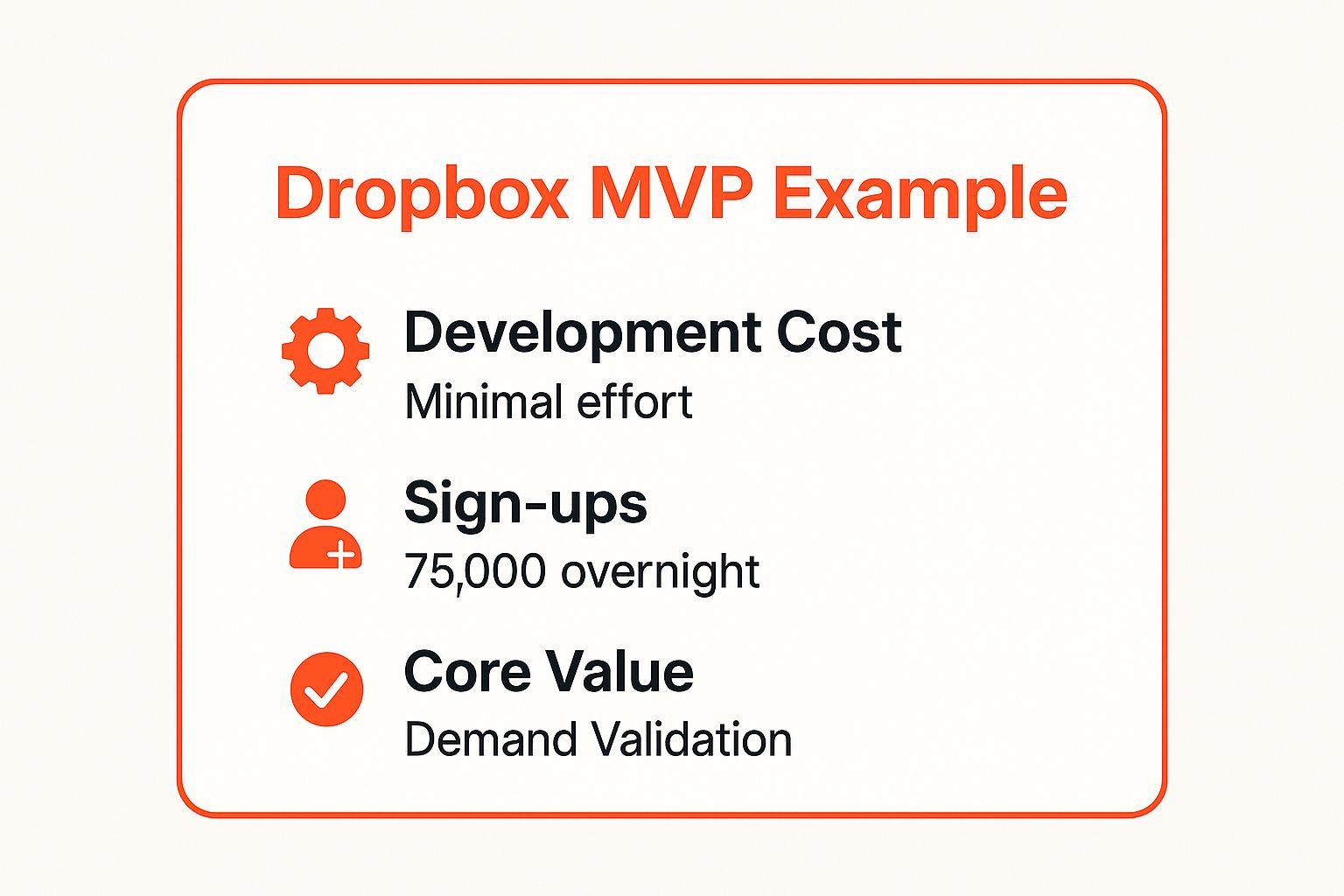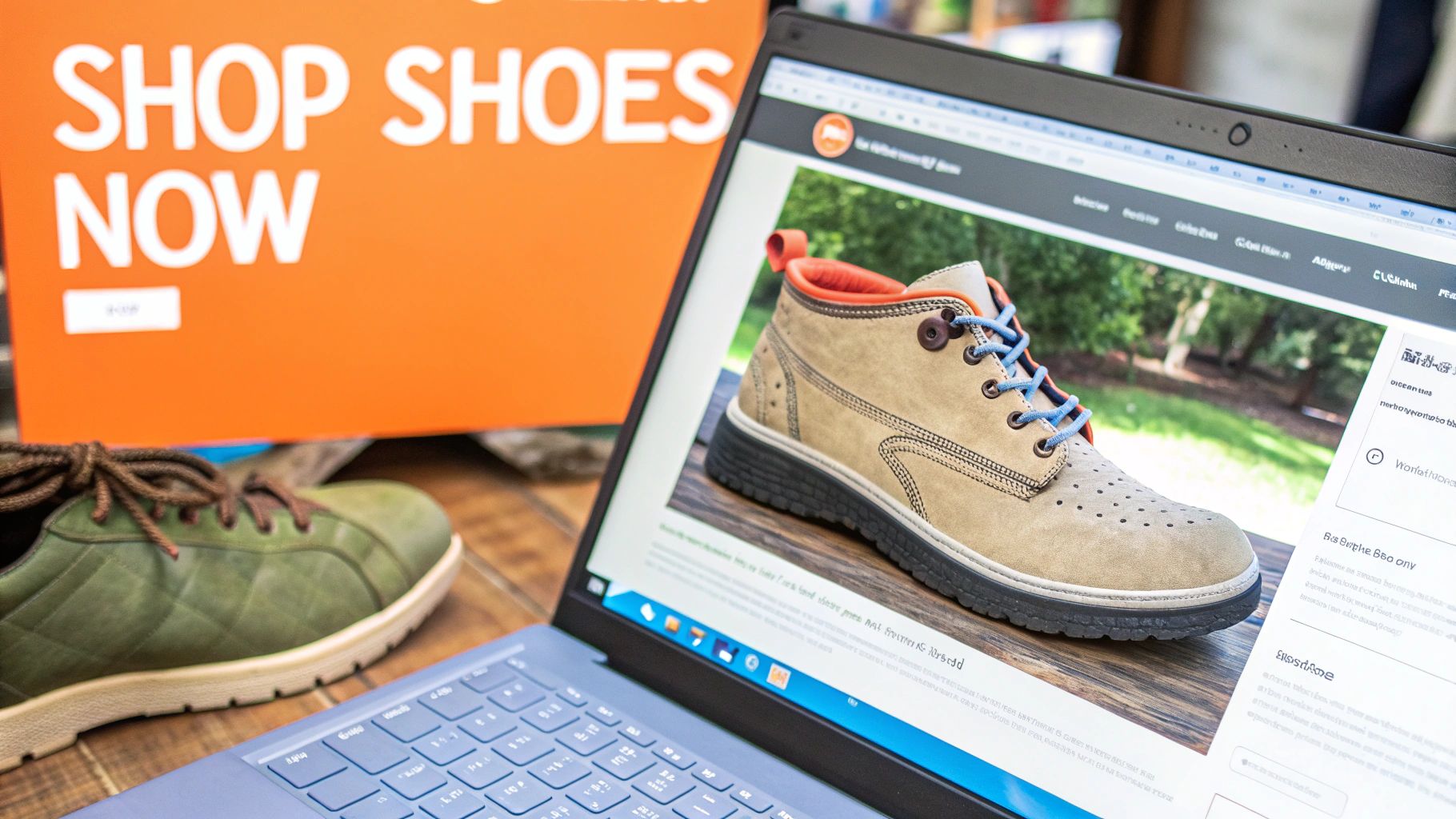The path from a brilliant idea to a successful startup is paved with assumptions. A Minimum Viable Product (MVP) isn't just a basic version of your product; it's a strategic tool designed to test your most critical assumption with the least amount of effort. It’s the difference between building something people might want and proving they actually need it. Getting this right is fundamental, but where do you find a problem worth solving in the first place? For indie hackers and solopreneurs, tools like ProblemSifter offer a direct line to validated pain points by analyzing Reddit communities, connecting you with the exact users expressing a need.
This article dissects the blueprint behind legendary MVPs. We'll analyze six iconic MVP example case studies, from Dropbox's simple demo video to Airbnb's spartan website, extracting the core strategies that turned a hypothesis into a market-defining company. You will learn precisely how these founders validated their core value proposition, minimized risk, and built momentum, often without writing a single line of complex code. For founders, indie hackers, and solopreneurs, mastering the art of the MVP is the first, most crucial step toward building a sustainable business. We’ll provide the actionable takeaways you need to apply these lessons to your own venture.
1. Dropbox - The Video Demo That Fooled Everyone (and Validated Everything)
In 2007, Drew Houston and Arash Ferdowsi faced a classic startup dilemma. They had a technically complex idea: a service that would seamlessly synchronize files across all of a user's devices. The problem was twofold. First, building the actual product would require immense technical effort and capital. Second, the concept itself was difficult to explain to potential users and investors who were accustomed to USB drives and emailing files to themselves.
Instead of building a buggy, partial prototype, they opted for a radically simple Minimum Viable Product (MVP) that wasn't a product at all. It was a video. Houston created a simple, three-minute screencast demonstrating how Dropbox would work. The video, narrated by Houston himself, was filled with in-jokes and references tailored to its target audience on the tech news site Digg. It showed a user effortlessly dragging files into a folder on one computer, only to have them instantly appear on another. It was a flawless simulation of the core value proposition.
Strategic Analysis
The genius of this MVP example lies in its focus on demand validation over product development. Houston understood that the biggest risk wasn't technical feasibility; it was market apathy. Would anyone even want this?
"It was critical that we showed people what it felt like to use Dropbox... you had to see it to understand it."
- Drew Houston
This "video-as-an-MVP" approach allowed them to test their core hypothesis, "people want seamless file synchronization," without writing a single line of production code for the complex backend. The video did all the heavy lifting of explaining the concept and generating excitement.
Key Outcomes and Takeaways
The response was immediate and overwhelming. To visualize the impact of this simple video, here is a quick reference summarizing the key results.

The data clearly shows how a low-cost, low-effort MVP can produce massive results by focusing exclusively on validating market demand. The viral success of the video not only built a huge waitlist of eager early adopters but also provided the social proof needed to secure crucial early-stage funding. This is a powerful lesson for founders: your first MVP doesn’t need to be a functional product, it just needs to prove that people want your solution. This approach is perfect for ideas that are hard to explain but solve a deep-seated user frustration.
2. Airbnb - The Manual Process That Built a Global Marketplace
In 2007, designers Brian Chesky and Joe Gebbia couldn't afford their San Francisco rent. With a major design conference coming to town and hotels fully booked, they saw a unique opportunity. They decided to rent out three air mattresses on their living room floor to attendees, creating a simple website called "Air Bed & Breakfast" to advertise their space. This wasn't a sophisticated platform; it was a basic, Craigslist-style site with photos of their apartment and the airbeds.
The founders manually handled everything. They took the photos, communicated with guests via email, processed payments themselves, and acted as the hosts. This hands-on approach, often called a "Concierge" or "Wizard of Oz" MVP, was the ultimate test of their core hypothesis: would strangers be willing to pay to stay in someone else's home?

Strategic Analysis
The Airbnb MVP example is a masterclass in validating a high-trust concept with minimal technology. The biggest risk for Airbnb wasn't building a booking engine; it was overcoming the immense social barrier of trust between strangers. By acting as the hosts themselves, they could directly experience user pain points, build initial trust, and gather priceless feedback on the entire user journey.
This manual, high-touch strategy allowed them to learn what truly mattered to both hosts and guests. They discovered that professional photography dramatically increased bookings, a lesson they learned by personally going door-to-door to photograph early listings. This direct interaction was far more valuable than any automated survey could have been.
"Do things that don't scale. You need to do things that don't scale in order to get to that next level of growth."
- Brian Chesky
Their strategy focused on proving the core transaction was viable before investing in automation. This approach is fundamental for founders looking to test an idea that relies heavily on human behavior and interaction.
Key Outcomes and Takeaways
Though their first launch only attracted three guests, the experience provided irrefutable proof that the core concept worked. It validated the idea that, under the right circumstances, people would choose a stranger’s air mattress over an expensive hotel. This initial traction, however small, was the critical data point they needed. For founders looking to apply these lessons, the key is validating ideas with real-world interactions.
This manual process directly unearthed the problems users faced, a principle championed by modern tools. For example, a platform like ProblemSifter helps founders find validated problems by analyzing discussions on Reddit. Unlike other tools, ProblemSifter doesn’t just suggest ideas—it connects you to the exact Reddit users asking for them. This approach of finding raw, unfiltered pain points before building is exactly what Airbnb did, albeit manually. The core takeaways from this iconic MVP example are clear:
- Solve Your Own Problem: The most authentic businesses start by addressing a genuine need the founders personally experience.
- Prioritize Learning Over Scaling: By handling every step manually, you gain deep insights into the customer journey that are impossible to get otherwise. Document these steps to create a blueprint for future automation.
- Build Trust First: For any marketplace or peer-to-peer service, establishing trust is the most critical hurdle. The MVP must directly address this.
3. Zappos - Proving a Market Exists by Faking It
In 1999, the idea of buying shoes online was almost laughable. Consumers wanted to try shoes on, feel the materials, and check the fit. Nick Swinmurn believed this assumption was wrong, but he needed proof. The core question wasn't about building a sophisticated e-commerce site; it was, "Will people actually trust a website enough to buy shoes they've never seen in person?"
Instead of investing in inventory, a warehouse, or complex logistics, Swinmurn created one of the most famous MVP examples ever. He went to local shoe stores, took photographs of their inventory, and posted them on a basic website called Shoesite.com. When a customer placed an order, he would return to the store, purchase the shoes at full retail price, and ship them to the customer himself. He was essentially running a business at a loss to answer a single, critical question.

Strategic Analysis
The brilliance of the Zappos MVP was its laser focus on validating the core assumption with zero inventory risk. Swinmurn's hypothesis was simple: people will buy shoes online if the selection is vast and the experience is reliable. Building out the infrastructure to support this would have been prohibitively expensive. This "Wizard of Oz" approach, where the manual effort behind the curtain simulates a fully functional system, was the perfect test.
"I wanted to test the hypothesis that customers were ready and willing to buy shoes online... The goal was to prove demand, not build a business right away."
- Nick Swinmurn (paraphrased)
This MVP model separated market risk from execution risk. By acting as the middleman, Swinmurn proved that a market existed before investing a single dollar in inventory. He validated customer demand firsthand, feeling the pain of the process, which also gave him invaluable insight into what a real solution would require, especially in terms of customer service.
Key Outcomes and Takeaways
This manual, unprofitable process was the critical first step that allowed Zappos to grow into a billion-dollar company acquired by Amazon. It proved that the biggest barrier wasn't technology; it was consumer trust.
The key lesson here is to de-risk your biggest assumption first. For many e-commerce or physical product ideas, that assumption is, "Will someone pay for this?" This MVP example shows you can find the answer without a warehouse full of products. You can apply this today by creating a simple landing page or using drop-shipping to test product-market fit before committing significant capital. By proving demand first, you build a business on a foundation of evidence, not hope.
4. Buffer - The Landing Page That Built a Business
In 2010, Joel Gascoigne had an idea for a tool that would let users schedule social media posts in advance. Like many founders, he was hesitant to invest months building a full-featured product that nobody might want. The core question wasn't "Can I build this?" but rather, "Will anyone pay for this?" This is a critical distinction that shapes the entire early-stage validation process.
To answer that question, Gascoigne created an extremely simple Minimum Viable Product: a two-page website. The first page was a landing page that clearly explained the value proposition: "Tweet more consistently with Buffer." It had a single call-to-action button, "Plans and Pricing." When a user clicked it, they were taken to a second page explaining that the product wasn't ready yet but they could enter their email to be notified. This simple flow was designed to test one thing: user intent.
Strategic Analysis
Buffer’s MVP is a masterclass in testing willingness to pay before building. By placing a pricing page as a gate before the email signup, Gascoigne was filtering for serious users, not just curious visitors. He was validating the business model, not just the product idea. This simple, two-step funnel gave him a powerful signal.
"I didn't want to get caught up building a product no one would use. The lean startup methodology was my guide, and I wanted to validate my idea as quickly and cheaply as possible."
- Joel Gascoigne
This approach directly measures the most critical assumption for any SaaS business: will customers pay? Gascoigne even added a pricing table with three tiers on the second page to gauge which features and price points resonated most. The data collected from clicks on different plans provided invaluable early market research, guiding the initial product roadmap.
Key Outcomes and Takeaways
This ultra-lean landing page MVP was far more than a simple email collection form; it was a powerful market validation engine.
- Initial Validation: The initial landing page gathered enough email sign-ups to confirm interest.
- Pricing Validation: When Gascoigne added the pricing page, a significant percentage of people still clicked through and left their email, validating that users were willing to pay for the solution.
- Customer Development: Gascoigne personally emailed every single person who signed up. He used these conversations to understand their specific pain points, which helped him refine the feature set for the first real version of Buffer. This direct feedback loop is crucial for building a product people truly need.
This strategy is an exceptional MVP example for founders who need to validate a business model with minimal resources. Instead of just asking, "Do you like this idea?" it asks a much more important question: "Are you interested enough to consider paying for this?" By focusing on intent and willingness to pay, Buffer laid the foundation for a successful, customer-funded business before writing a single line of backend code.
5. Uber - The Hyper-Focused, High-End Launch
Before Uber became the global transportation behemoth it is today, it was 'UberCab', a remarkably simple iPhone application with a singular purpose. In 2010, Garrett Camp and Travis Kalanick launched a service that did just one thing: connect users in San Francisco with a premium black car service at the push of a button. There were no different car types, no split fares, no dynamic "surge" pricing, and no complex rating systems.
The MVP was a bare-bones app that solved a very specific, high-value problem for a niche market. For tech professionals and urbanites in San Francisco, hailing a traditional taxi was often unreliable and unpleasant. UberCab’s MVP offered a premium, seamless alternative. By focusing exclusively on a high-margin segment (luxury black cars) in a single, tech-savvy city, they could test their core hypothesis: "will people pay a premium to request a private car via a mobile app?"
Strategic Analysis
Uber's strategy was a masterclass in geographic and demographic hyper-targeting. Instead of trying to serve everyone, they chose a small, influential user base that was less price-sensitive and more likely to appreciate the convenience of a tech-driven solution. This allowed them to prove the business model and fine-tune operations on a manageable scale.
"We weren’t trying to build a global transportation network from day one. We just wanted to solve a personal frustration: getting a cab in San Francisco."
- A core sentiment from Uber's early days
This approach de-risked the entire venture. The biggest unknown wasn't if they could build an app, but if they could successfully manage the two-sided marketplace of riders and drivers. Starting small and premium created a controlled environment to balance supply and demand before expanding to more complex, lower-margin segments. This is a critical step in any new product launch, a process that can be further refined using a detailed product launch checklist to ensure no crucial steps are missed.
Key Outcomes and Takeaways
The initial focus on a premium service created a powerful "velvet rope" effect, generating buzz and establishing a brand associated with quality and reliability. This initial traction proved the model worked and attracted the investment needed for aggressive expansion.
The UberCab MVP provides a powerful blueprint for founders. By starting with a focused, high-value niche, you can validate your core concept with paying customers, generate higher initial margins, and build a strong foundation before tackling the broader market. This is an excellent MVP example for any startup entering a crowded space or building a two-sided marketplace. It proves that starting small and focused is often the fastest path to building something big.
6. Twitter - The Internal Tool That Became a Global Phenomenon
In 2006, the podcasting company Odeo was facing an uncertain future as Apple's iTunes began to dominate the space. During an internal "hackathon" day, employee Jack Dorsey pitched a simple idea: a web-based service allowing users to share short status updates with a small group, similar to SMS. The concept, initially codenamed "twttr," was built as a basic internal communication tool for Odeo employees.
The MVP was incredibly rudimentary. It was a simple system where team members could text a message to a specific number, and that message would be broadcast to all other team members who had subscribed. The famous 140-character limit wasn't a strategic product decision but a technical constraint imposed by the SMS protocol. This simple, real-time status-sharing tool formed the entire basis of the initial product.
Strategic Analysis
Twitter's MVP is a prime example of the "dogfooding" strategy, where a company uses its own product to solve its own problems. By building "twttr" for internal use, the team became their own first users. This provided an immediate, high-fidelity feedback loop without the complexities of external customer discovery.
"We built it for ourselves... we weren't thinking about it as a business. We were just thinking, 'This is a fun thing.'"
- Biz Stone, Co-founder
This approach allowed them to test the core interaction loop, "post and follow," in a low-risk environment. The biggest risk wasn't building the technology; it was discovering if this behavior was compelling enough to stick. Using it internally proved its addictive, real-time nature before it ever faced the public. They validated the core user behavior hypothesis first.
Key Outcomes and Takeaways
The internal adoption at Odeo was swift and enthusiastic. Employees were constantly checking their phones for updates, proving the concept's inherent "stickiness." This internal validation gave the founders the confidence to spin it out as a separate company.
This "internal tool" MVP is a powerful lesson in starting small and solving a problem you understand intimately. By focusing on a single, core utility for a known user group (themselves), the founders avoided feature bloat and validated the product's fundamental value. This method is perfect for founders looking to test a new interaction model or social dynamic. Building for your own team first allows you to iterate rapidly based on genuine, daily use, providing a strong foundation before scaling to a wider audience.
MVP Examples Feature Comparison
| Example | Implementation Complexity | Resource Requirements | Expected Outcomes | Ideal Use Cases | Key Advantages |
|---|---|---|---|---|---|
| Dropbox - File Sharing Video Demo | Very low (video production) | Minimal technical development | Validate demand; generate signups | Early concept validation; investor interest | Low cost; quick market test |
| Airbnb - Simple Website for Rentals | Low (basic website + manual ops) | Low initial development; high manual effort | Validate marketplace concept; gain customer feedback | Peer-to-peer marketplaces | Direct user feedback; simple setup |
| Zappos - Drop-shipping Shoe Store | Low to moderate (basic ecommerce + manual processing) | No inventory needed; manual order handling | Validate product demand; reduce risk | E-commerce product validation | No inventory investment; low risk |
| Buffer - Landing Page with Email Signup | Very low (simple two-page site) | Minimal or zero development | Validate demand and pricing; build email list | SaaS or service pricing validation | Zero development cost; quick research |
| Uber - Simple Black Car Service App | Moderate (iOS app, limited features) | Mobile development for one platform | Validate ridesharing concept; premium market | Geographically focused service launch | Focused UX; premium positioning |
| Twitter - Internal Team Communication Tool | Low (SMS-based, basic app) | Leverages existing SMS system | Validate real-time communication; internal feedback | Internal communication tools; real-time updates | Simple core concept; quick feedback |
How to Find Your Own MVP-Worthy Problem
As we've explored through the seminal MVP examples of Dropbox, Airbnb, and Buffer, the core lesson is strikingly consistent. The most successful minimum viable products are not born from complex technology or massive feature sets. They emerge from a laser-focus on solving a single, acute, and validated problem for a specific group of people.
Dropbox didn't build a cloud storage empire overnight; it started by showing a video to prove a simpler file-syncing concept. Airbnb didn't launch a global hospitality platform; it put up a simple website to rent air mattresses to conference-goers. Each MVP example in this listicle demonstrates a fundamental truth: before you build the product, you must validate the problem. Their initial versions were radically simple, designed for one purpose only: to get a "yes" or "no" answer to their core hypothesis from the market with minimal investment.
From Inspiration to Action: Validating Your Idea
The founders of these now-famous companies had a distinct advantage: they were their own first customers. They felt the pain of forgetting a USB drive or struggling to find affordable lodging. But you don't need to stumble upon a problem accidentally. Today, the most valuable insights are hiding in plain sight within online communities. For an indie hacker or solopreneur, Reddit is an unfiltered source of insight for finding real user pain points. The key is shifting your mindset from "building a solution" to "finding a problem worth solving."
This is where a strategic approach to idea validation becomes your greatest asset. Instead of building in a vacuum, you can tap directly into the unfiltered conversations happening on platforms like Reddit. Analyzing these discussions reveals the frustrations, desires, and feature requests of real people. This method transforms ideation from a guessing game into a data-driven process.
For founders, indie hackers, and solopreneurs, this is a game-changer. Tools built for this exact purpose can provide a significant competitive edge. ProblemSifter, for instance, is designed to analyze communities like r/SaaS and r/solopreneur to surface real, validated problems people are actively discussing. It doesn't just give you a generic idea; it provides the context, the original Reddit post, and even the usernames of the people expressing the pain point.
This direct connection is invaluable. It helps founders both ideate and promote their solution with targeted outreach, allowing you to:
- Validate Demand: Confirm that the problem you want to solve is a recurring, painful issue for a specific audience.
- Refine Your MVP: Understand the specific features and outcomes users are asking for, helping you scope a truly minimum and viable product.
- Identify Early Adopters: Build a list of your first potential customers before you even write a line of code.
For just $49, you can get lifetime access to a curated list of real startup problems people are discussing in one subreddit ($99 for three). With no subscriptions and no hidden fees, it's a powerful and competitive alternative to expensive market research tools. Mastering the art of the MVP isn't just about learning from a famous MVP example; it's about systematically finding and validating a problem of your own. By leveraging modern tools to listen to communities, you can de-risk your venture and build something people are already waiting for.
Ready to stop guessing and start solving? Use ProblemSifter to discover validated startup ideas directly from the communities you want to serve. Find your next MVP-worthy problem today by exploring real user pain points on Reddit. Get started with ProblemSifter.
